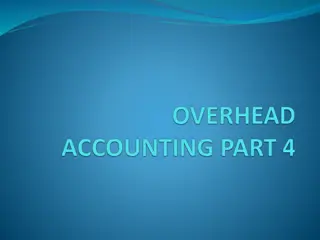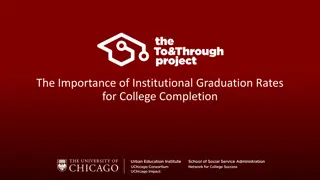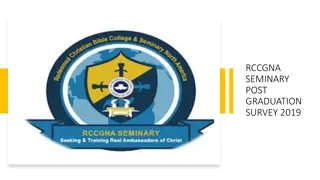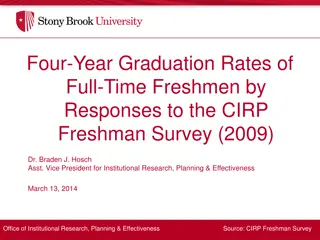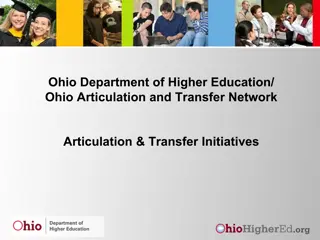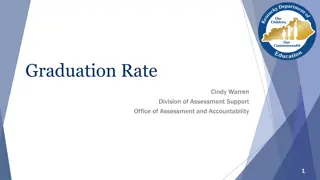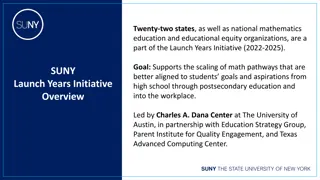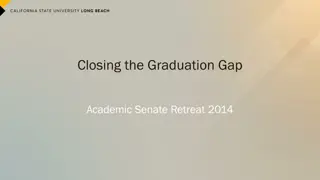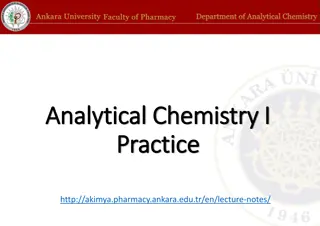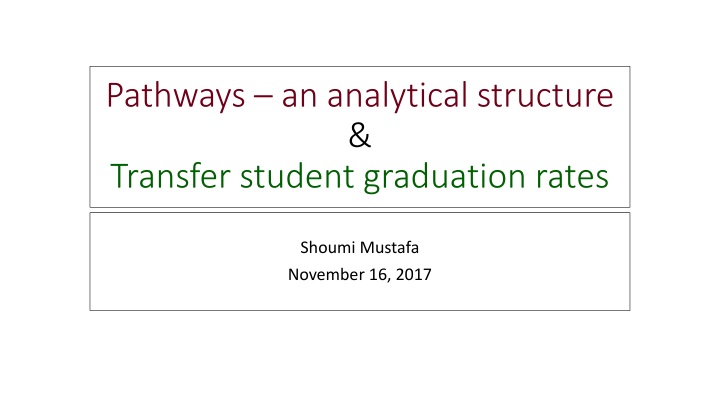
Mapping Pathways from Two-Year to Four-Year Degrees
Explore the process of mapping pathways from two-year college associate degrees to four-year college baccalaureate degrees in specific disciplines. Discover how institutions compare regarding the graduation rates of transfer-out and transfer-in students, and learn about the options available for students based on associate degree types and preferred baccalaureate disciplines.
Download Presentation

Please find below an Image/Link to download the presentation.
The content on the website is provided AS IS for your information and personal use only. It may not be sold, licensed, or shared on other websites without obtaining consent from the author. If you encounter any issues during the download, it is possible that the publisher has removed the file from their server.
You are allowed to download the files provided on this website for personal or commercial use, subject to the condition that they are used lawfully. All files are the property of their respective owners.
The content on the website is provided AS IS for your information and personal use only. It may not be sold, licensed, or shared on other websites without obtaining consent from the author.
E N D
Presentation Transcript
Pathways an analytical structure & Transfer student graduation rates Shoumi Mustafa November 16, 2017
Pathways An analytical structure & Transfer student graduation rates How do we map pathways from two-year college associate degrees to four-year college baccalaureate degrees in specific disciplines? How do our two-year and four-year institutions compare regarding their respective rates of graduation of transfer- out and transfer-in students? Depending on associate degree types, areas of concentration, and preferred baccalaureate degree disciplines, students have varied options leading to baccalaureate degrees. We provide comparable among institutions graduation rates for transfer- out and transfer-in students. We provide a general analytical framework for mapping the pathways. Specific examples are provided in handouts. Relevant rates for specific sub-populations are included in handouts. 2
From associate to baccalaureate degrees Associate degrees granted by Ohio public two-year institutions fall in two broad categories: Applied & Technical: Associate of Applied Business (AAB); Associate of Applied Science (AAS); Associate of Technical Studies (ATS) & Associate of Information Technology (AIT). Arts & Sciences Associate of Arts (AA) & Associate of Science (AS). Depending on the associate degree type and the pathways students choose, they have varied options leading to baccalaureate degrees. The required combination of courses in four-year institutions depend on the following: Type of associate degree & area of concentration Preferred baccalaureate degree discipline 3
Information for developing pathways An efficient system eliminates course duplication, and ensures that credits accumulated under associate degrees apply to meeting baccalaureate degree requirements. In order to develop efficient pathways, we need mappings of pathways leading to prominent baccalaureate degree disciplines; we need information on the following: Associate degree types + Associate degree area concentrations Subsequent four-year institution enrollment Baccalaureate degree receipt Baccalaureate degree discipline Baccalaureate degree names and degree granting institutions 4
Two-year college associate degrees in 2009-10: Distribution of degree type All Associate Degrees* N: 14,861 Arts/Science Degrees: Applied/Technical Degrees N:3,220 N: 11,641 (21.5%) (77.8%) AS: AA: AA & AS: ATS: AAB: AAS: N:960 N:2,157 N:103 N:344 N:2,480 N:8,817 AAB: Associate of Applied Business; AAS: Associate of Applied Science; ATS: Associate of Technical Studies; AA: Associate of Arts; AS: Associate of Science. *An additional 73 individuals had received both Applied/Technical & Arts/Science degrees, and another 33 had received Associate degrees in Individual Studies. Those 106 students are excluded from the chart. 5
Progression from associate to baccalaureate degrees: All associate degree recipients All Associate Degrees N: 14,861 Arts/Science Degrees: Applied/Technical Degrees N:3,220 (22.2%) N: 11,641 (77.8%) Four-year enrollment: Four-year enrollment: 1,569 (48.8%) 2,575 (22.1%) Graduation: Graduation: 1,304 (50.8%) 1,100 (70.1%) Note: Four-year enrollment refers to attendance at Ohio public four-year main and regional campuses. 6
Framework for mapping pathways: Case study Baccalaureate degree in Business In mapping pathways from associate degree types to baccalaureate degrees in business, we combine the associate degrees to obtain the following classifications. 1. Associate of Applied Business degree recipients 2. Combined group: (Associate of Applied Science + Associate of Technical Studies) Business concentration 3. Combined group: (Associate of Applied Science + Associate of Technical Studies) Non- Business concentration 4. Combined group: (Associate of Arts + Associate of Science) Business concentration 5. Combined group: (Associate of Arts + Associate of Science) Non-Business concentration Note: The following subjects are classified as parts of the Business Discipline by the Higher Education Information System (HEI) of the Ohio Department of Higher Education: Accounting, Administrative and Secretarial, Business - Other, Computer and Quantitative Business Fields, Finance, General Sales, Merchandising and Related Markets, Human Resources Management and Labor Studies, Logistics, Management, Marketing, and Service Business. 7
Progression to baccalaureate degrees in Business: Numbers All Associate Degrees N: 14,861 AA + AS: Business Conc. N=124 AA + AS: AAS + ATS: Business Conc. N=485 AAS + ATS: Non-Business Conc. N=8,676 AAB Non-Business Conc. N=3,096 N=2,480 Enrollment: Enrollment: Enrollment: Enrollment: Enrollment: 87( 17.9%) 2,062 (23.8%) 75 (60.5%) 1,495 (48.3%) 426 (17.2%) Graduation: Graduation: Graduation: Graduation: Graduation: 233 (54.7%) 52 (59.8%) 1,024 (49.7%) 1,043 (69.8%) 57 (76.0%) AAB: Associate of Applied Business; AAS: Associate of Applied Science; ATS: Associate of Technical Studies; AA: Associate of Arts; AS: Associate of Science. 8
Distribution of baccalaureate degree disciplines: Associate of applied business degrees Chart 1. Distribution of Baccalaureate Degree Disciplines: For Associate of Applied Business Degree Recipients 60.0% 54.1% N=126 Natural Science & Mathematics Information Technology: 17 Information Science: 5 Computer System & Networks: 3 Computer Science & information Science: 2 Mathematics, General: 2 Mathematics & Computer Science: 1 50.0% 40.0% 30.0% 20.0% 14.6% Total number of baccalaureate degrees: N=233 N=34 8.6% 8.6% N=20 10.0% 4.7% N=20 3.0% 3.0% 2.6% 0.9% N=11 N=7 N=7 N=6 N=2 0.0% Natural Science & Mathematics Social & Behavioral Sciences Arts & Humanities Business Education Engineering Health Law Services Applied Business 8.6% 54.1% 4.7% 2.6% 3.0% 0.9% 14.6% 3.0% 8.6% 9
Distribution of baccalaureate degree disciplines: Associate of applied science & technical studies business concentration Chart 2. Distribution of Baccalaureate Degree Disciplines: For Associate of Applied Science & Technical Studies (Business Concentration) 45.0% 42.3% N=22 40.0% Number of Degrees in Natural Science & Mathematics Computer Science: 14 35.0% 30.0% 26.9% N=14 25.0% 20.0% 17.3% N=9 15.0% 10.0% Total number of baccalaureate degrees: N=52 5.8% 3.8% N=2 3.8% 5.0% N=3 N=2 0.0% 0.0% 0.0% 0.0% Natural Science & Mathematics Social & Behavioral Sciences Arts & Humanities Business Education Engineering Health Law Services AAS+ATS - Business 5.8% 42.3% 0.0% 0.0% 3.8% 0.0% 26.9% 3.8% 17.3% 10
Transfer student graduation rates: How do institutions compare? Two samples. Sample 1: First-time (FT) two-year college attendees in 2009-10. Sample 2: All two-year college attendees in 2009-10. Statistics: The number of transfer-out students by two-year institutions. Graduation rates of transfer-out students by institution. The number of transfer-in students by four-year institutions. Graduation rates of transfer-in students by institution. Data source: Higher Education Information system (HEI) of the Ohio Department of Higher Education (ODHE) and the National Student Clearinghouse (NSC). 11
Sample 1: First-time (FT) two-year college students in 2009-10 Students who attended any public two-year institutions in Ohio between Summer 2009 and Spring 2010 as first-time undergraduates. Students who had previous enrollments in institutions of higher education as high-school students are included in the sample. 12
Sample 1: FT students Transfer-outs and graduation rates: Definitions Who is a transfer-out student? First-time two-year college students from the 2009-10 cohort who attended a four-year university anywhere in the nation within six years from initial enrollment between 2009-10 and 2014-15 How do we define graduation rates of transfer-out students for a two- year institution? A transfer-out student is considered to have graduated if s/he received a baccalaureate degree within six years of initial enrollment by 2014-15. We obtain transfer-out graduation rates relevant to a two-year institution by dividing the number of (transfer-out) graduates from the institution by the total number of transfer-out students from the institution. 13
Sample 1: FT students Transfer-out student numbers: By institution Tranfser-Out Numbers: By Institution Columbus State 3,463 Cuyahoga Community 2,995 Sinclair 1,700 Cincinnati State 1,395 Owens State 1,281 Stark State 912 Lakeland 873 Lorain County 775 Hocking College 345 Central Ohio Tech. 290 Southern State 222 James A. Rhodes 214 Zane State 214 Clark State 212 Edison State 200 North Central State 196 Eastern Gateway 180 Northwest State 180 Washington State 162 Belmont 159 Terra State 144 Marion Technical 101 0 500 1,000 1,500 2,000 2,500 3,000 3,500 4,000 14
Sample 1: FT students Transfer-out graduation rates: By institution Transfer-Out Graduation Rates: By Institution Lorain County Comm. College 42.3% Lakeland Community College 39.5% Cuyahoga Community College 36.2% Eastern Gateway Comm. College 33.9% Edison State Comm. College 31.5% Northwest State Comm. College 28.9% Sinclair Community College 28.8% All two-year institutions 28.3% Owens State Community College 27.8% Columbus State Comm. College 27.5% Cincinnati State Comm. & Tech 26.7% Washington State Comm. College 24.1% Belmont Technical College 22.0% Clark State Community College 20.3% Terra State Community College 20.1% North Central State College 18.9% Southern State Comm. College 16.7% Central Ohio Technical College 14.5% James A. Rhodes State College 14.5% Stark State College of Tech. 13.5% Zane State College 12.6% Hocking College 11.0% Marion Technical College 10.9% 0 5.0% 10.0% 15.0% 20.0% 25.0% 30.0% 35.0% 40.0% 45.0% 15
Sample 1: FT students Definitions: Transfer-in students and graduation rates Who is a transfer-in student? Students from the first-time two-year college cohort who had transferred to Ohio s public four-year university main campuses within six years of initial enrollment between 2009-10 and 2014-15. How do we define graduation rates of transfer-in students for a four- year institution? A transfer-in student is considered to have graduated if s/he received a baccalaureate degree within six years of initial enrollment by 2014-15. We obtain the transfer-in graduation rates relevant to a four-year institution by dividing the number of (transfer-in) graduates to the institution by the total number of transfer-in students to the institution. 16
Sample 1: FT students Transfer-in student numbers: By institution Transfer-In Student Numbers: By Institution Ohio State University 1,019 Cleveland State University 879 Wright State University 597 University of Toledo 435 Ohio University 429 University of Akron 421 Kent State University 401 University of Cincinnati 367 Bowling Green State University 321 Youngstown State University 136 Shawnee State University 82 Central State University 48 Miami University 48 0 100 200 300 400 500 600 700 800 900 1,000 1,100 17
Sample 1: FT students Transfer-in graduation rates: By institution Transfer-In Graduation Rates: By Institution Miami University 52.1% Bowling Green State University 51.1% Ohio State University 41.4% University of Cincinnati 40.6% Kent State University 36.7% Cleveland State University 33.8% Ohio University 33.1% University of Toledo 30.3% All Four-Year University Main Campuses 29.5% Wright State University 29.1% University of Akron 22.6% Youngstown State University 16.2% Shawnee State University 7.3% Central State University 6.3% 0.0 10.0% 20.0% 30.0% 40.0% 50.0% 60.0% 18
Sample 2: All two-year college students in 2009-10 All students who attended any of the 23 two-year public institutions in Ohio between Summer 2009 and Spring 2010. The sample includes first-time undergraduates as well as students with previous undergraduate/graduate enrollments. Sample 1 includes only first-time, Ohio public two-year college students in 2009-10 (the FT sample). Sample 2, the larger sample, includes all Ohio public two-year college students in 2009-10. All criteria used in defining transfer-out and transfer-in students, and their respective graduation rates are identical between the two samples. 19
Sample 2: All students Transfer-out student numbers: By institution Transfer-Out Student Numbers: By Institution Columbus State Comm. College 14,302 Cuyahoga Community College 11,775 Sinclair Community College 8,477 Owens State Community College 5,769 Cincinnati State Comm. & Tech 5,426 Lorain County Comm. College 4,290 Stark State College of Tech. 3,778 Lakeland Community College 3,692 Hocking College 1,277 Clark State Community College 1,264 Central Ohio Technical College 1,180 North Central State College 964 Zane State College 957 James A. Rhodes State College 944 Southern State Comm. College 897 Edison State Comm. College 786 Northwest State Comm. College 607 Marion Technical College 533 Belmont Technical College 510 Terra State Community College 488 Eastern Gateway Comm. College 479 Washington State Comm. College 393 Rio Grande 154 0 3,000 6,000 9,000 12,000 15,000 20
Sample 2: All students Transfer-out graduation rates: By institution Transfer-Out Graduation Rates: By Institution Lorain County Comm. College 46.5% Lakeland Community College 36.8% Edison State Comm. College 35.6% Northwest State Comm. College 35.4% Cuyahoga Community College 34.5% Sinclair Community College 33.0% Columbus State Comm. College 32.1% Owens State Community College 31.6% All two-year institutions 31.4% Washington State Comm. College 31.3% Eastern Gateway Comm. College 30.1% Terra State Community College 28.3% Clark State Community College 28.1% Rio Grande 27.9% Cincinnati State Comm. & Tech 26.5% Southern State Comm. College 24.5% James A. Rhodes State College 24.3% North Central State College 24.2% Central Ohio Technical College 23.0% Belmont Technical College 21.6% Hocking College 21.1% Zane State College 20.7% Stark State College of Tech. 18.2% Marion Technical College 17.5% 0.0 10.0% 20.0% 30.0% 40.0% 50.0% 21
Sample 2: All students Transfer-in student numbers: By institution Transfer-In Student Numbers: By Institution Cleveland State University 4,923 Ohio State University 4,557 Ohio University 4,051 Wright State University 3,428 University of Toledo 2,050 University of Cincinnati 1,855 University of Akron 1,836 Kent State University 1,755 Bowling Green State University 1,423 Youngstown State University 650 Shawnee State University 247 Miami University 206 Central State University 205 0 1,000 2,000 3,000 4,000 5,000 22
Sample 2: All students Transfer-in graduation rates: By institution Transfer-In Graduation Rates: By Institution Miami University 51.5% Bowling Green State University 51.3% Ohio State University 47.7% University of Cincinnati 41.3% Wright State University 41.2% Cleveland State University 40.9% All four-year main campuses 40.8% Kent State University 40.2% Ohio University 38.6% Youngstown State University 33.9% University of Akron 33.7% University of Toledo 33.5% Central State University 24.9% Shawnee State University 15.4% 0 10.0% 20.0% 30.0% 40.0% 50.0% 60.0% 23
What did we learn? Pathway mapping: Applied degrees account for between 70% & 80% of all associate degrees granted by Ohio public two-year institutions in a year. Subsequent four-year college enrollment patterns show potentials for increasing baccalaureate degree numbers; only a fifth of applied associate degree recipients attend four-year institutions. Graduation rates: Two-year institutions with strong (regional) ties with four-year institutions have higher rates of transfer-out graduation rates. High transfer-in graduation rates for four-year institutions receiving large- scale student movements show the other side of the beneficial linkage. 24


